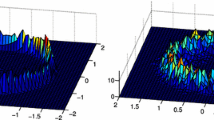Abstract
We consider a collective motion algorithm for a swarm of homogeneous agents in a stationary environment. The agents cooperatively locate the boundary of a given environmental function in two space dimensions. Applications include tracking oil slicks, algae blooms, and other environmental indicators that occupy a localized area with a well defined boundary. Individual agents are controlled by local rules based on “snake” algorithms from image segmentation. In a previous paper we introduced a method in which the boundary tracking motion was driven by an edge detector for the concentration boundary. In this chapter we consider a simpler method in which the agents find a pre-specified level set of the environmental concentration. We consider performance of the algorithm in the presence of sensor noise.
Access this chapter
Tax calculation will be finalised at checkout
Purchases are for personal use only
Preview
Unable to display preview. Download preview PDF.
Similar content being viewed by others
References
R. Cassinis. Landmine detection methods using swarms of simple robots. In E. Pagello, editor, International Conference on Intelligent Autonomous Systems, volume 6, Venice, Italy, 2000.
L. Cohen. On active contour models and balloons. Comput. Vision, Graphics, and Image Processing: Image Understanding, 53, 1991.
J. Desai, V. Kumar, and J. Ostrowski. A theoretical framework for modeling and controlling formations of mobile robots. IEEE Trans. on Robots and Automations. Under review.
T. Estlin, G. Rabideau, D. Mutz, and S. Chien. Using continuous planning techniques to coordinate multiple rovers. Elec. Trans. on AI, 4: 45 - 57, 2000.
D. Fox, W. Burgard, H. Kruppa, and S. Thrun. Collaborative multi-robot exploration. Autonomous Robots, 8, 2000.
M. Kass, A. Witkin, and D. Terzopoulos. Snakes: Active contour models. International J. of Computer Vision, pages 321 - 331, 1988.
D. Marthaler and A. Bertozzi. Collective motion algorithms for determining environmental boundaries. UCLA CAM preprint (http://www.math.ucla.edu/applied/cam/index.html), 2002.
T. McInerney and D. Terzopoulos. T-snakes: Topology adaptive snakes. Medical Image Anal., 4, 2000.
Nekton Research LLC.http://www.nektonresearch.com
P. Ogren, E. Fiorelli, and N. Leonard. Formations with a mission: Stable coordination of vehicle group maneuvers. In Proc. 15th Int’l Symposium on Math. Theory of Networks and Systems, 2002.
J. C. Strikwerda. Finite Difference Schemes and Partial Differential Equations. Chapman and Hall, New York, 1989.
D. Terzopoulos. Regularization of inverse visual problems involving discontinuities. IEEE Transactions PAMI, 8: 413, 1986.
Author information
Authors and Affiliations
Editor information
Editors and Affiliations
Rights and permissions
Copyright information
© 2004 Kluwer Academic Publishers
About this chapter
Cite this chapter
Marthaler, D., Bertozzi, A.L. (2004). Tracking Environmental Level Sets with Autonomous Vehicles. In: Butenko, S., Murphey, R., Pardalos, P.M. (eds) Recent Developments in Cooperative Control and Optimization. Cooperative Systems, vol 3. Springer, Boston, MA. https://doi.org/10.1007/978-1-4613-0219-3_17
Download citation
DOI: https://doi.org/10.1007/978-1-4613-0219-3_17
Publisher Name: Springer, Boston, MA
Print ISBN: 978-1-4613-7947-8
Online ISBN: 978-1-4613-0219-3
eBook Packages: Springer Book Archive




